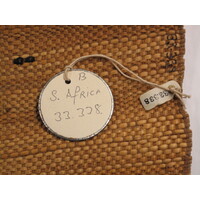Circular label with metal outline tied to spoon/bag
Metadata
Circular label with metal outline tied to spoon/bag
[ Source of title : Rachel Hand for MAA ]
Object
Textual record
1933.338
Creative Commons License: CC BY-NC-ND https://creativecommons.org/licenses/by-nc-nd/3.0/
Accession numbers [Source - Nessa Leibhammer for FHYA, 2012, using MAA materials: Cat ID: 109391; ID NO: 1933.338; MAA num: Catalogue no. 119 a]
Attributions and conjectures [Source - Nessa Leibhammer for FHYA, 2012, using MAA materials: Names: Spoon - MAA (01/12/1998) Bag - MAA (01/12/1998) Classified: Keyword: Tools; Containers; Basketry Material: Wood; Basketry Descriptions: Wooden spoon, with band of carving halfway along handle, contained in long, narrow bag of basketwork. The bag is used only by chiefs or headmen. Catalogue no. 119 a. Bought just North of Jamieson's Drift... - MAA (01/12/1998) Local: Maker: Cultural Group: Zulu Author: Date Made: Dimensions: Source: Sayce, R. U. (donor) Source Date: Place: Africa; Southern Africa; South Africa; North of Jamieson's Drift - MAA (01/12/1998) Africa; Southern Africa; South Africa; Zululand - MAA (01/12/1998) Period: Contexts: MAA (00/00/0000) Updated: 03/12/2004 Created: 01/12/1998]
[Source - Rachel Hand for MAA, 2016: The Museum's catalogue cards and labels are part of the institution's and the objects' very history. Catalogue cards were created to add additional object information from the very first accessions back in 1884 and replacement cards were made if the original was lost, usually using both different pens and terms. Original sale or collector labels could be stuck to the cards to add biographical layers of information in the same way that letters and later photographs were sometimes attached to cards. Staff and sometimes visitors would add comments on provenances, measurements and locations over time. Reconnecting an author with their annotations can add to our knowledge of the object's history and associations. The era and author of the cards also is reflected in their physical aspects: initially details were handwritten in ink, the 1930s saw cards stamped and written on a typewriter, followed variously by handwritten details in ballpoint pen, finally moving to word-processed and laser printed texts. Like the cards the physical type of paper and pen used can suggest dates as well as authors. They can be used to confirm the identity of misplaced objects, e.g. Henry Bulwer's collection bears distinctive long, rectangular shaped paper labels and his cursive script. Early labels were handwritten in ink, on small rectangular paper or parchment label and tied through small metal reinforced holes. Others were glued directly to the object. Smaller rectangular or square paper labels, with a printed outline, usually stuck directly to the object, usually originate in late nineteenth or early twentieth century salerooms or via a collector. Larger circular, metal-edged labels were written in the museum, probably from the 1970s onwards. The 1980s bought larger labels on thick yellow paper, and remained handwritten. From c.2000, we have used acid-free yellowish paper labels, that are written on in light-sensitive and waterproof ink.]
| Event Actor | Event Type | Event Date | Event Description |
|---|---|---|---|
| Five Hundred Year Archive (FHYA) | Online curation | 2016 - | Digital image by Nessa Leibhammer |
| Museum of Archaeology and Anthropology, University of Cambridge (MAA) | Making | YYYY |

Contributions